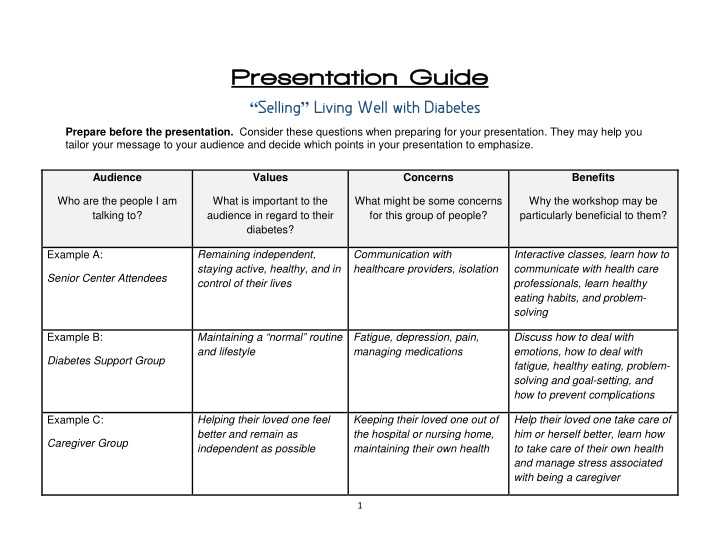



Presen entatio ion G n Guid ide “ Selling ” Living Well with Diabetes Prepare before the presentation. Consider these questions when preparing for your presentation. They may help you tailor your message to your audience and decide which points in your presentation to emphasize. Audience Values Concerns Benefits Who are the people I am What is important to the What might be some concerns Why the workshop may be talking to? audience in regard to their for this group of people? particularly beneficial to them? diabetes? Example A: Remaining independent, Communication with Interactive classes, learn how to staying active, healthy, and in healthcare providers, isolation communicate with health care Senior Center Attendees control of their lives professionals, learn healthy eating habits, and problem- solving Example B: Maintaining a “normal” routine Fatigue, depression, pain, Discuss how to deal with and lifestyle managing medications emotions, how to deal with Diabetes Support Group fatigue, healthy eating, problem- solving and goal-setting, and how to prevent complications Example C: Helping their loved one feel Keeping their loved one out of Help their loved one take care of better and remain as the hospital or nursing home, him or herself better, learn how Caregiver Group independent as possible maintaining their own health to take care of their own health and manage stress associated with being a caregiver 1
Brief Presentation for Living Well with Diabetes I’m here to tell you about an exciting new program we’re starting. It’s a workshop called Living Well with Diabetes and it was developed and researched at Stanford University of California to improve health and confidence, reduce hospitalizations, doctor visits, and emergency department visits for people with type 2 diabetes, pre-diabetes and those who live with someone who does. How many of you have diabetes, or have a friend or relative who has type 2 diabetes? Pause . It’s serious, isn’t it? It’s tough how it can really change your life, what you eat, and how you live . The statistics about diabetes are very staggering: Did you know that … (pick 3-5 statistics that are relevant to your audience). Here are the sources retrieved in 2017: Center for Disease Control (CDC) https://www.cdc.gov/diabetes/pubs/statsreport14/national-diabetes-report-web.pdf American Diabetes Association (ADA) http://www.diabetes.org/diabetes-basics/statistics/#sthash.SG2TKv7U.dpuf http://main.diabetes.org/dorg/PDFs/Advocacy/burden-of-diabetes/minnesota.pdf Centers for Medicare & Medicaid Services (CMS) https://www.cms.gov/research-statistics-data-and-systems/statistics-trends-and-reports/chronic-conditions/downloads/2012chartbook.pdf • Approximately 466,638 people in Minnesota, or 10.5% of the adult population, have diabetes. Around 26,000 new cases are diagnosed in Minnesota each year (ADA). • Diabetes and prediabetes cost an estimated $4.4 billion in Minnesota each year (ADA). • The total Direct and Indirect cost for diabetes in the U.S. is estimated at $245 billion (CDC). $176 billion for medical costs and $69 billion in reduced productivity. That is 2.3 times higher medical costs than those without diabetes. (ADA) • Around 1 in 4 people with diabetes do not know that they have the disease. (ADA) • Prevalence of diabetes in Seniors is high: The percentage of Americans age 65 and older is 25.9%, or 11.2 million seniors (diagnosed and undiagnosed). (ADA) • 28% - that’s more than 1/4 - of all Medicare beneficiaries had diabetes in 2010. (CMS) • The risk of death among people with diabetes is 1.5 times higher than those without diabetes of similar age. (CDC) • Diabetes is the leading cause of blindness, heart disease, stroke, amputation of lower extremities, kidney disease, and death. (ADA). 2
What would you think of spending just 2-1/2 hours a week for six weeks to learn how you can take control of your diabetes and your life? Here’s what you’ll learn: healthy eating preventing or delaying complications reading nutrition labels and preventing low blood sugar planning low-fat meals fun ways to get active tips for talking with your doctor and family about your diabetes foot care and general health You’ll learn from two Leaders and the rest of your group. This is NOT a lecture, rather, it’s a workshop where everyone participates and can learn from each other. How many of you would be interested in attending this workshop to develop tools to live a healthier life? Excellent! Here’s some information on how to register (printed materials). Go over the details: • date, day, and time of event • location • phone number • website • cost I look forward to having each of you join the workshop, feel free to bring a friend. Remember class size is limited to 8-16 people, so please register as soon as possible! Thank you! Do you have any questions? 3
Recommend
More recommend